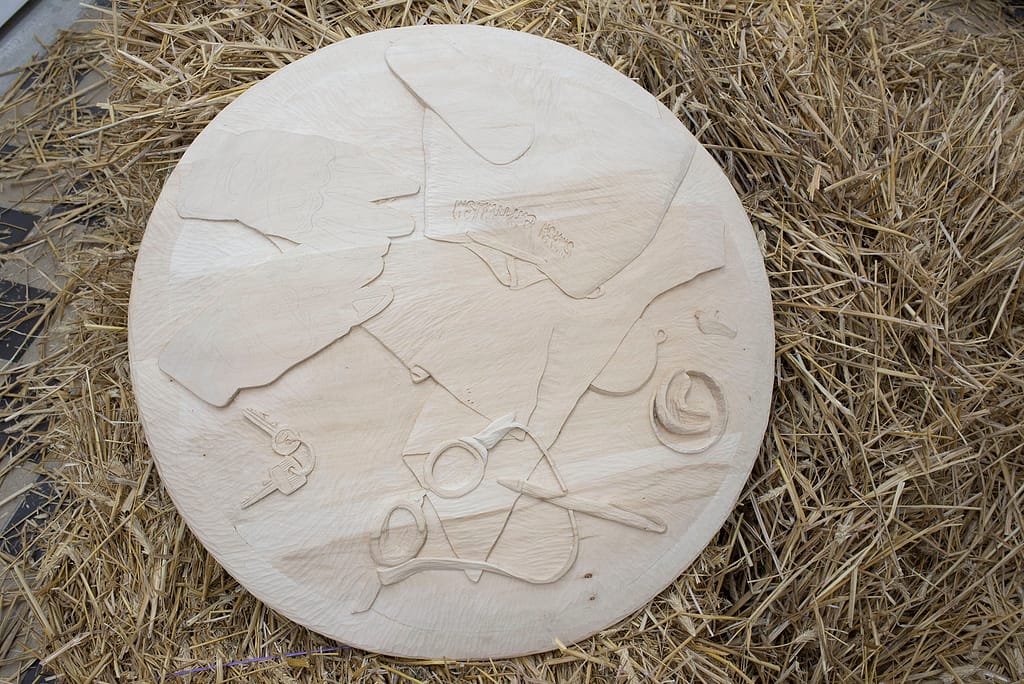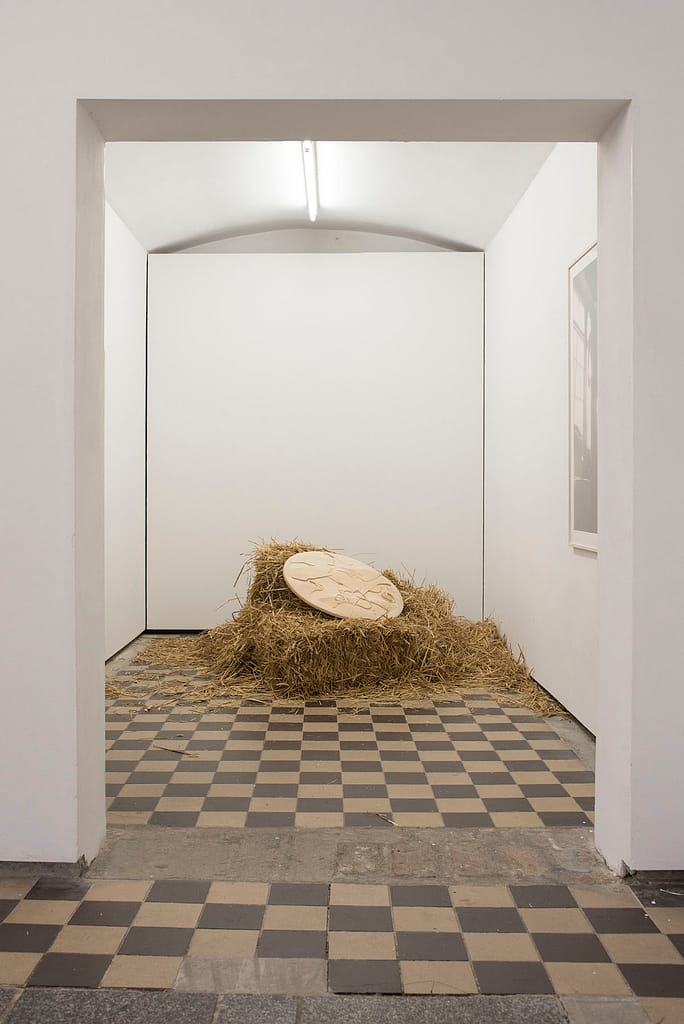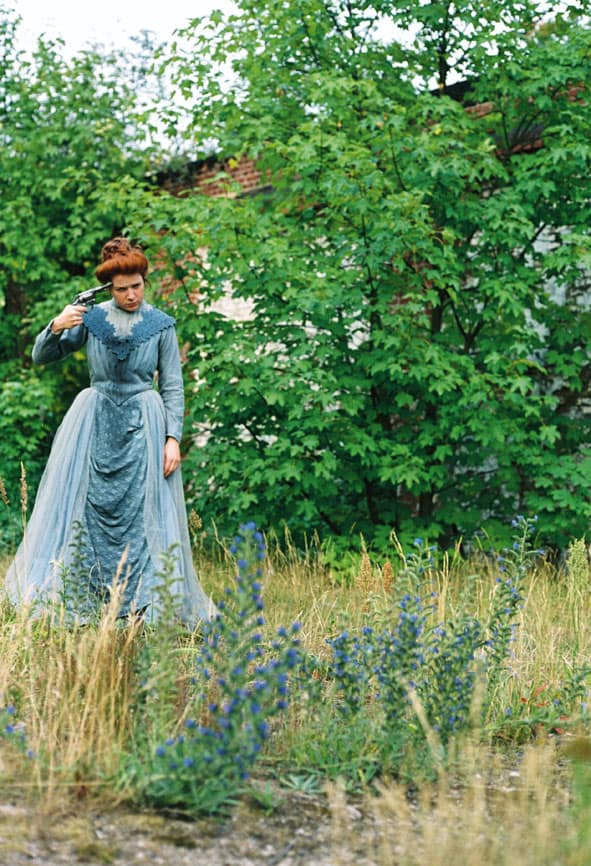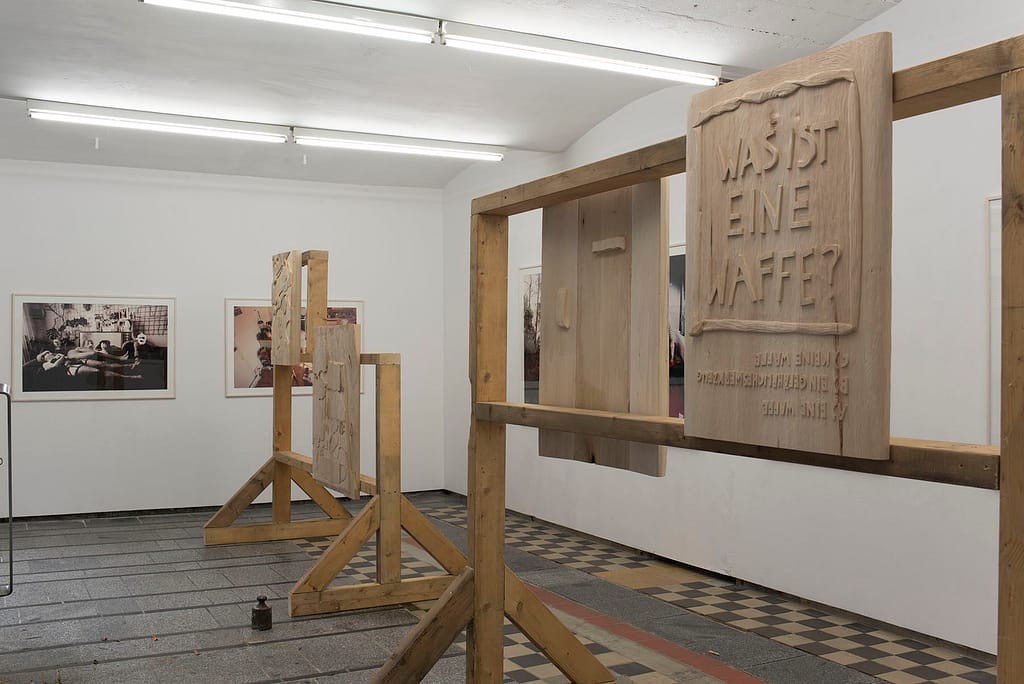Claudia Reinhardt & Cornelia Herfurtner
exhibition: September 5 – October 4, 2020
Due to the current situation no opening will take place. We invite you to visit the exhibition in the presence of the artists. Email after-the-butcher to request your visit. Please wear a mouth and nose protection mask when entering the exhibition space:
September 4, 6-10 p.m., September 12, 19, 26 and October 3, 3-6 p.m.
September 19, 7 p.m. Book Release: Witwen/Widows, Claudia Reinhardt, The Green Box, 2020
Sunday October 4, Finissage 3-8 p.m. 3D film screening at 6 p.m. of Flipping the Stationary Car, 2018 by Cornelia Herfurtner, David Iselin-Ricketts, John Allan MacLean (45min). Visit only by prior appointment until latest Sunday October 4, 11 p.m. at: ina@after-the-butcher.de
Passive Bewaffnung (Passive armament)
Legally speaking, we currently commit an offense with every organized gathering of people. Thanks to Covid-19, Germany is now passively armed, masks and protective screens concealing our faces, obligated to disguise. What happened? After 1968, protesters in 1970s Federal Republic of Germany increasingly began to use face masks in order to protect their personal rights – after all, taking to the streets risked recognition and subsequent dismissal from work or school. Ever since the passing of anti-terrorist legislation in 1977, masked protestors are not only deemed to expect, but to provoke violence. With the birth of ‘passive Bewaffnung’ came the prohibition of masked protests. Following Brokdorf and the anti-nuclear movement, laws were tightened: Anyone wearing protective gear in anticipation of police violence was now considered passively armed. Meanwhile, ever since the GSG 9 unit, their counterpart’s appearance has grown to resemble military expeditions against their own citizens with each May 1st protest – or the G20 summit. Protestors, on the other hand, are called to avoid helmets, goggles, protective gloves, mouthguards – and to best leave their keys at home if they are on their way to a protest. At present, the issue of active self-protection against potential threats is delicate to say the least: Who wears masks for the benefit of or protection against whom? Who or what constitutes the adversary? Cornelia Herfurtner’s sculpted reliefs are still lifes of a history of the FRG about uprising and repressive state power – a history to be continued.
Killing Me Softly
“To be nowhere, to stay nowhere. Diving, resting, moving without effort of force – and one day reflecting, reappearing, walking through a clearing […]. Start with the beginning.” (I. Bachmann, Undine leaves)
Suicide is a form of violence, but also of freedom. Between 2000 and 2004, Claudia Reinhardt photographically re-staged ten suicides of well-known artists* – personalities who fascinated her and whose work and life influenced her in her work. As a kind of personal tribute, Reinhardt allows fiction and reality to merge into one another, researching for each photo both in literature and in the archives what exactly drove those women* to say goodbye to life. The motives and methods are very different: there is the planned and precisely executed suicide, for example in the case of Sylvia Plath or Anne Sexton, and there is the slow destruction of one’s own body, such as Ingeborg Bachmann’s addiction to pills and alcohol. Reinhardt chooses a thoroughly psychological approach to her role models by slipping into the role of the dying herself: she reenacts the ten deaths, the moment equipped in every detail and allows herself to be photographed. If that adjective were not in exact opposition to what is depicted here, the scenery could indeed be described as “alive” due to its filmic character. What caused these women* to oppose, to withdraw from life? Unfortunately, the possible reasons still seem to be present: patriarchal, physical violence, fascist systems, lack of equal rights and recognition of their works, to name but a few. Without wanting to glorify suicide, Reinhardt’s photographs therefore also capture a moment of greatest self-determination.
“But I can’t go like this. So let me say good things to you once again, so that you won’t get divorced like this. So that nothing gets divorced.” (ibid.)
Nadja Abt, Berlin, 2020
Claudia Reinhardt
(* 1964 in Viernheim/South Hesse) studied at the University of Fine Arts, (*1964 in Viernheim/South Hesse) studied at the University of Fine Arts Hamburg. From 2000–2012, she taught as a professor in the department of photography at the National Art Academie in Bergen, Norway. Reinhardt became known, among other things, through her photographic work Killing Me Softly – Todesarten (Aviva Verlag, Berlin 2004), a series of photographs dealing with female artists who killed themselves. Reinhardt stages theses suicides using herself as a model. The work No Place Like Home (Verbrecher Verlag, 2005) is about the meaning of origin and identity. The work Tomb of Love (Verbrecher Verlag, 2016) again deals with the topic of suicide, staging couples who their own lives together. The work Widows and Widows is about mourning and remembrance, a documentary and conceptual photographic work, which will be published by The Green Box, Berlin, in 2020. Exhibitions: Haus am Kleistpark, Berlin (2018); Kunstgeschichtliches Museum, Osnabrück (2017); Galerie Malopolski Ogród Sztuki, Cracow (2016); Galerie im Körnerpark, Berlin (2015); Corean Art Museum, Seoul (2015); Galerie F15, Moss, Norway (2015); Contemporary Art Museum, Roskilde (2015); Fotogalleriet Format, Malmö (2014); Meta House, Phnom Penh (2011); Kunsthalle Memmingen (2010); IDFX, Breda Photo Festival, Breda (2007); Micro Museum, Zurich (2009); Brooklyn Museum, New York (2004) and others.
Cornelia Herfurtner
(*May 8, 1987) is an artist and organized in the Interventionist Left. As part of the alliance Disarm Rheinmetall, she works against arms production, arms exports and Germany’s largest arms producer Rheinmetall. As an artist, she works under her civil name as well as with the artist group Michelle Volta and the publishing house and bookshop b_books. Her most recent projects include a series of photographs entitled freedom and control of others (including myself) (published in starship #19) and the collectively taught seminar Self-Organization and University (with Ernest Ah and Anastasio Mandel, Berlin University of the Arts). Her video essay Frauen verlassen das Museum (in collaboration with David Polzin) can be seen at the Mitte Museum in Berlin-Wedding until January 2021.
Funded by:
















